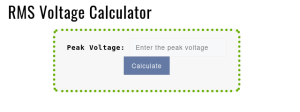RMS Voltage Calculator
RMS Voltage Calculator
RMS Voltage Calculator
The RMS (Root Mean Square) Voltage Calculator is a tool used to calculate the effective or average voltage value of an AC (Alternating Current) waveform. The RMS voltage is a measure of the power delivered by the AC signal and is commonly used to compare and analyze electrical systems.
Try our Energy Stored in a Capacitor Calculator.
Formula:
The formula to calculate the RMS voltage depends on the type of AC waveform. For a sinusoidal waveform (such as a pure AC signal), the RMS voltage can be calculated using the following formula:
RMS Voltage = Peak Voltage / √2
Here,
- Peak Voltage represents the maximum voltage value reached by the AC waveform.
It’s important to note that the RMS voltage calculation assumes a periodic waveform where the voltage varies sinusoidally. The formula assumes that the waveform is symmetric around the zero-voltage axis.
Example:
Let’s consider an AC signal with a peak voltage of 10 volts.
Using the formula for a sinusoidal waveform:
RMS Voltage = Peak Voltage / √2
RMS Voltage = 10 / √2 ≈ 7.07 volts
Therefore, the RMS voltage of the AC signal with a peak voltage of 10 volts is approximately 7.07 volts.
FAQs (Frequently Asked Questions):
- Why is RMS voltage important? RMS voltage is used to measure the effective or average voltage of an AC waveform. It is a crucial parameter in electrical engineering and power systems as it helps determine the power delivered by the AC signal. RMS voltage is essential for understanding electrical loads, designing circuits, and ensuring the safe operation of electrical equipment.
- Can the RMS Voltage Calculator be used for non-sinusoidal waveforms? The RMS voltage formula discussed here specifically applies to sinusoidal waveforms. For non-sinusoidal waveforms with complex shapes, the RMS voltage calculation may require additional techniques such as numerical integration or approximation methods. In such cases, it is recommended to use specialized software or tools designed for specific waveform analysis.
- What is the difference between peak voltage and RMS voltage? Peak voltage refers to the maximum voltage value reached by an AC waveform, while RMS voltage represents the effective or average voltage of the waveform. Peak voltage provides information about the magnitude of the waveform at specific moments, while RMS voltage indicates the equivalent DC voltage that would deliver the same power. RMS voltage is commonly used for power calculations and comparisons in AC systems.
The RMS Voltage Calculator simplifies the calculation of effective voltage values for sinusoidal AC waveforms. It provides an estimate of the average voltage delivered by the waveform based on its peak voltage. However, it’s important to consider waveform characteristics and use specialized techniques for non-sinusoidal waveforms or complex voltage variations.

Try more calculators:
Energy Stored in a Capacitor Calculator
